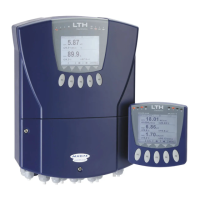Installation
MXD70 Conductivity Setup and
Operating Guide
- 7 -
Installation
Installation and Choice of Conductivity Sensors
The choice of the correct type of conductivity sensor, how and where to mount it, so that it has a
representative sample of solution are probably the two most important considerations when installing
a conductivity system.
The following criteria are of great importance during selection:
The choice of the best method of measurement
Selection of the correct (optimum) cell constant
Use of the correct materials for corrosion resistance
Position of sensor for robustness and service access
Ensuring a representative, uncontaminated solution sample
The following tips might be useful. The range of measurement will determine the cell constant. The
epoxy resin castings are extremely resistant to most acids and alkalis. A number of sensors have
stainless steel bosses and these should be avoided in the presence of chlorides, e.g. HCl.
There is also a growing tendency to passivate new pure water systems during commissioning, it is
imperative that any sensors are removed from the pipework prior to this because it forms a non-
conductive coating on the surface of the electrodes.
To ensure correct sensor mounting the following conditions should be observed:
The solution between the cell electrodes or around the sensor is representative of the solution as a
whole.
A moderate flow is maintained to provide an “up to date” sample. Excessive flow rates, however, can
cause cavitations and turbulence within the sensor, which will result in inaccurate readings.
The sensor is mounted so that air bubbles do not lodge within it - displacing solutions and affecting
the sample volume (air is not conductive).
Similarly it must be in a position so that sludge and particulate matter does not collect within the
sensor.
Conventional conductivity cells can suffer problems associated with direct electrical contact with
the solution where large electrical currents may be flowing, for example in electroplating tanks.
It is not uncommon for a cell to require cleaning on a weekly or daily basis, due to the nature of
chemicals used and the presence of scale in hard water areas, experience will determine the correct
maintenance periods.
Care and Maintenance of Conductivity Sensors
Conductivity measuring systems are designed to be trouble free in use and reliable measurements can
be expected during their operating life. However, some maintenance is required. In particular, the cell
and cable connections should be checked for security and freedom from corrosion. The sensor will also
require periodic cleaning, depending on the quality of the water passing through it and the type of
sensor employed. A dirty sensor will always give a low conductivity reading.
The area of the cell which is sensitive to fouling is the electrode surfaces which must fully "wet" to
ensure accurate measurements. Moulded cells are often used in applications where a high level of
contamination may be expected.

